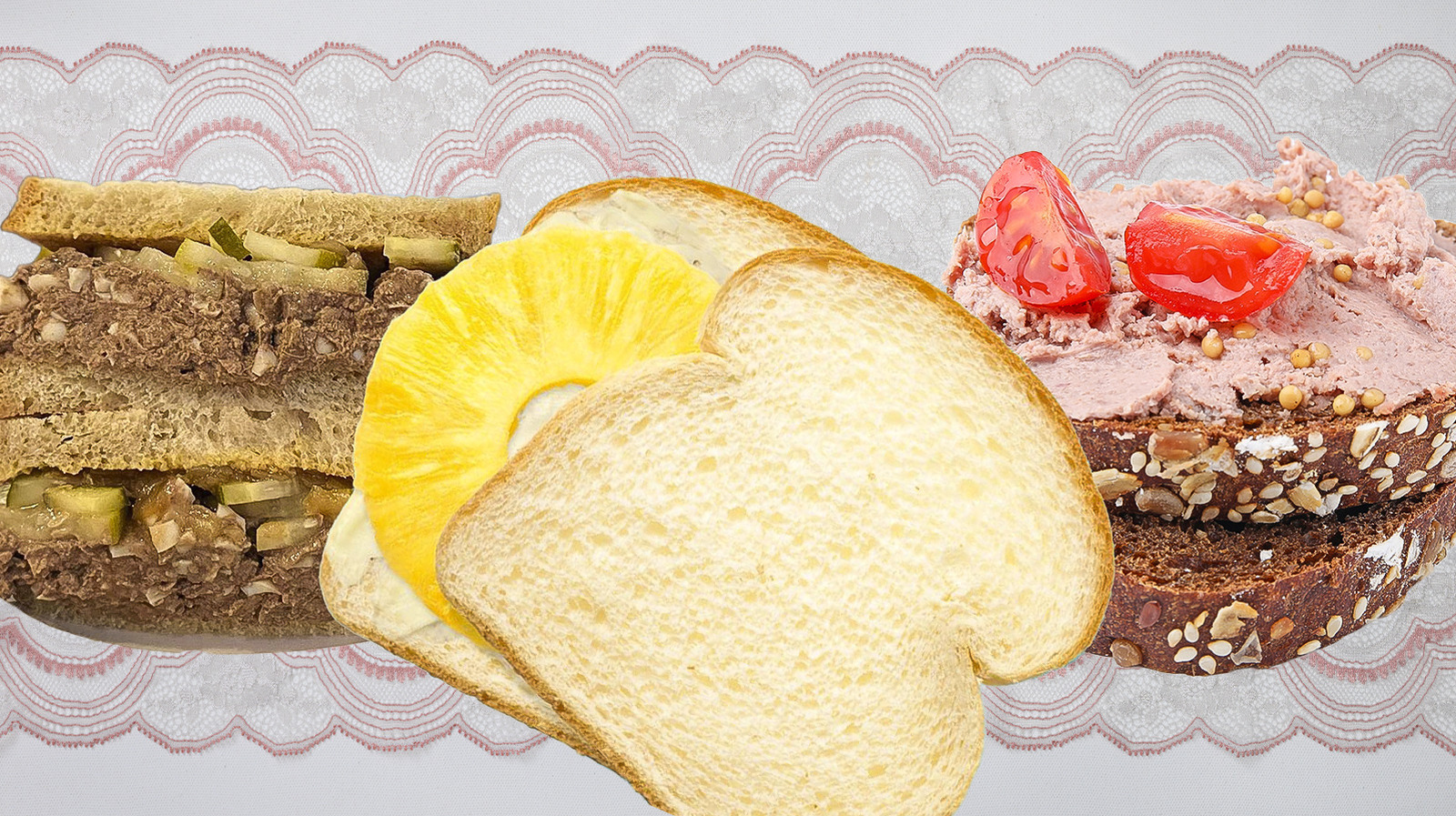Nothing beats a sandwich in a pinch. Bread, fillings, and spreads come together to make an almost magically easy, on-the-go meal and we can thank John Montagu for that. The prevailing story is that in 1762, the 4th Earl of Sandwich played a pivotal role in the creation of modern-day sandwiches by asking for an easy to eat meal while playing cards. Since then, sandwiches have exploded in popularity around the world, with different cultures creating their own.
While sandwiches have stood the test of time, what we fill them with changes often, as trends do. Some vintage foods that our grandparents, or even our own parents, ate might sound pretty inedible now, but they were popular during their heyday for a reason. So we’re going back in time to explore 13 sandwich recipes best left in the past. And before we get too in the weeds, we know there are probably some people out there still eating these sandwiches and liking them — to that, we say power on.
Pineapple sandwich
Southerners in the United States seem to love a sandwich composed of soft, fluffy white bread with a thick layer of mayonnaise in the middle (Duke’s, preferably, though we imagine Hellmann’s could do in a pinch). But instead of bacon or tomato, the filling of this sandwich is something fruitier and much sweeter.
It’s said that the pineapple sandwich got its start in Pine Apple, Alabama and not too long after its inception James Dole opened his first pineapple canning facility. Canned foods provided a convenient and reliable way for people to store food long-term, without worrying too much about expiration dates or food going bad. Due to that, some people say that the invention of canned pineapple, in particular, made the availability and consumption of pineapple sandwiches greater. Those who still eat these sandwiches today aren’t too precious about whether to use crushed, canned, or fresh pineapple, but mayonnaise is certainly not the first-choice fruit sandwich condiment anymore.
Olive loaf sandwich
Olive loaf is a type of bologna that comes in a tube (or loaf) shape, and has pimento cheese stuffed green olives in it. Some people consider its closest deli meat cousin to be that of mortadella, though there are distinct differences between bologna and mortadella, namely in their ingredients. But olive loaf certainly follows in bologna’s footsteps as a hodgepodge of meats with the distinction of spices and olives.
It’s difficult to say who first created olive loaf, but bologna is often given credit as an American dish having taken inspiration from the aforementioned mortadella. There’s a high likelihood that it was one of many products to take off in popularity during the ’60s and ’70s when processed meats became a more economical and available option. Those that eat olive loaf take the meat’s briny flavor into consideration, cutting the saltiness with water-forward vegetables in their sandwiches like tomatoes or lettuce. Other toppings include cheese and it wouldn’t be a vintage recipe without a hearty helping of Miracle Whip as well. For those who want to take a walk down memory lane, it may be difficult since olive loaf’s lack of popularity has hindered it’s sales. As such, it isn’t as readily available as turkey or ham, though online retailers do still sell it.
Tomato and onion sandwich
Tomatoes on sandwiches make perfect sense, especially to those in the American South. To make the best tomato sandwich of your life, you’ll need to choose the right tomato — the juicier and bigger, the better. Then it’s time to boost a tomatoes flavor with a pinch of salt. However, while there’s nothing controversial about a delicious ripe tomato on fresh bread, the addition of onion can cause a bit of a stir.
Normally, combining the two ingredients on a sandwich is hardly newsworthy, except when the sandwich consists of those two ingredients alone. In this case, it’s an intense yet simple sandwich that doesn’t require any refrigeration and can be made quite cheaply, which is perhaps the reason it spread in popularity, resulting in a lingering nostalgia for the sandwich. Purists stick to tomato, mayonnaise, and onion only despite naysayers and detractors. However, the addition of seasonings like salt and pepper, or even balsamic vinegar and olive oil, could add depth and cut down on the lingering taste of the onion that people often try to avoid.
Banana, peanut butter, and mayo sandwich
Love it or hate it, mayonnaise is inextricably linked to sandwiches and the condiments’ tie to the Southern United States can’t be understated. Despite this, it may be surprising that the creamy, tanginess of mayonnaise was purposefully combined with the sweet, nutty flavors of bananas and peanut butter. Turns out, this sandwich has been eaten since the Great Depression, at least. Most people outside of the South likely haven’t heard of it, but even though we’re almost a century beyond from the Depression, these sandwiches still have a lingering fan or two.
Now, a typical version of this sandwich will feature mayonnaise and sliced bananas on white bread alone, which is said to have a tangy, creamy, and slightly sweet taste, though the texture could be a turnoff for some. Variations are quite common and the biggest is adding peanut butter, which is a more common and palatable pairing with banana. With all three ingredients together, it’s quite the polarizing sandwich due to many people’s disdain for mayonnaise and the unpleasant mouthfeel we’re sure exists after a bite or two.
Fish and peanut butter
Stick with us here, but peanuts and fish are apparently a match made in sandwich heaven for some and the flavor combination is actually not all that unheard of. In West Africa there’s groundnut stew — or peanut and fish soup — which creates a broth base out of peanut butter. Peanut butter and fish soups also exist in South American cuisine, as with Ecuadorian fish soup, but it’s certainly not on the menu rotation at most American restaurants due to the unconventional nature of the flavor profiles.
Canning food was invented in 1809 as a means of preserving food and became a primary source of sustenance for the poor, especially for items like fish which were only available fresh if you lived on the coastline. As a result, people of the past likely had to find creative ways of not only stretching food, but diversifying flavors requiring the mix of reliable foods in the hopes of concocting a new classic. Due to the experimentation factor, there doesn’t seem to be agreement on the ideal type of peanut butter used (chunky or smooth, sweetened or unsweetened) in the sandwich recipe, and the fish used can differ as well. Canned sardines have been used, as well as canned tuna fish.
Prune sandwich
Prunes are often thought of as a food well-loved by the elderly, given the juice’s benefit to those with digestive issues, but the fruit has far more uses than that. From cakes to meat dishes, prunes have long been a versatile ingredient. Like many other dried fruits, they have a concentrated sweetness and ultra-chewy texture with a subtle earthiness. Many food pairings including prunes are still eaten today, but they’re not exactly an ingredient we’d think of to succeed in a sandwich.
Nevertheless, prune sandwiches seem to have been popular in years past. One sandwich recipe calls for chopped prunes, toasted almonds and relish resulting in an earthy, nutty, and sour bite all in one. Other iterations include diced bologna alongside the dried fruit. With the current reputation of prunes, it may be difficult to understand why they were so popular decades prior, but an abundant supply and the fruits touted health benefits may have had something to do with it. These days other fruits are more likely to fill sandwiches, like those in Japanese fruit sandos or grapes in chicken salad.
Deviled ham and horseradish sandwich
Deviled eggs have a storied past, beginning perhaps in the 13th century in ancient Andalusia. In short, “deviled” means “spicy or highly seasoned” and since today’s deviled eggs are made with smoked paprika, as well as other family secret ingredients, that definition makes sense. But eggs aren’t the only “deviled” food. Another less common option that’s gotten the same treatment is deviled ham. It takes ham — canned or fresh — and chops it up ultra-fine before mixing it with mayonnaise, spices, and seasonings.
Deviled ham is used as a dip, topping, or in the case of sandwiches, as a spread. Alone, this is similar to a chicken salad or egg salad, but the addition of horseradish sets this sandwich apart. Likely taking after the long-term relationship between deli meat and boldly flavored condiments, a deviled ham and horseradish sandwich certainly warrants a breath mint after eating. Horseradish has a pungent, biting flavor that can overwhelm the palate and it can taste quite bitter when fresh — though there are steps to get around that. One recipe calls for grated horseradish to be mixed into the deviled ham directly, but any form of horseradish, whether it be sauce or slices, could be used for what is sure to be a very distinct tasting sandwich.
Liverwurst sandwich
Liverwurst is a sausage made from pork or beef liver — among other organ meats — and got its start in Germany, though plenty of people around the world have since made it a part of their diets. However, when you walk into a sandwich shop on the East Coast or the West Coast, you probably won’t find it on the menu. Sure, you may see Italian cold cuts or processed versions of chicken or beef, but liverwurst is often left out, and there’s a reason for that.
Whether in sausage or pâté form, liverwurst has a rich and savory flavor that can be on the salty side, with an unmistakable meatiness to it. As both a processed meat and an organ meat, liverwurst has been a resourceful way to avoid waste and not break the bank leading to it becoming an integral part of some culture’s cuisines in the past. Sandwiches featuring liverwurst are mostly just like any other sandwich with bread, a condiment — usually mustard or mayonnaise — lettuce and onion, except liverwurst gives off a rather strong, sometimes metallic, taste. Due to that, and the fact that it’s an offal meat (which we don’t eat much of anymore), liverwurst is not a sandwich for everyone, but leaves a nostalgic feeling for some.
Frosted sandwich loaf
Hearing the term “sandwich loaf” might make you think of bread loaves that, when sliced, are used to hold sandwich fillings. That would be incorrect in the case of the frosted sandwich loaf, which is a layered sandwich (like a club sandwich) with an outside that’s “frosted” with a mixture of mayonnaise, cream cheese, and heavy cream. It’s thought that the American frosted sandwich loaf is a descendant of the Swedish Smörgåstårta (with origins dating back to the ’30s), with different fillings adapted for American tastes.
The inside layers of the sandwich can have a multitude of fillings, depending on personal preference, and the number of layers can vary, with each layer having the same filling or different ones. One recipe shared four fillings— pimento cheese, egg salad, deviled ham, and chicken salad — though another opted for three — tuna salad, egg salad, and pimento cheese. It’s easy to guess how the flavor meld of the different types and textures of fillings may be overwhelming for some. On top of that, frosted sandwich loaves don’t offer a quick fix since they can take upward of 1.5 hours to put together.
Cream cheese and olive sandwich
Olives are an integral part of many cultures’ diets in the Middle East and Mediterranean. And with the advent of mass olive oil production, households around the world can enjoy the result. Martinis have never looked better. At one point, olives were so exotic in the United States that they were considered a must-have part of holiday celebrations like Thanksgiving. So it’s perhaps not that surprising that olives have always had their moment in the sun whether it be in preparation of food or as the main course.
In sandwich form, olives have been used in deli meat (hello again, olive loaf), toppings, and in the case of a cream cheese and olive sandwich, as the main event. Green olives have been used before, but most recipes call for pimento stuffed olives, chopped well and then mixed with a block of cream cheese. Other additions can include mayonnaise, chopped nuts, or hot sauce, depending on the day. For modern tastes, olives are sometimes found in cream cheese spreads for morning bagels, but less so as a filling in a traditional sandwich. The reason may simply come down to toasting. Putting cream cheese and olives on a warm, toasted bagel causes the cream cheese to soften and it can cause a shift in the flavor of the olive. In the end, that slight difference in texture, temperature, and taste can set olive forward cream cheese apart from the experience of eating it on an untoasted piece of white bread.
Bacon and prune sandwich
Bacon is a favorite breakfast food for many, and it can fit into almost any meal at any time, whether sprinkled over a side of green beans or crumbled on top of a twice-baked potato. As a meat, bacon is especially well know for what it adds to sandwiches, particularly the BLT. Yet despite all the sandwich recipes we can think of that people often eat bacon with today, one with prunes still seems a little outlandish.
However, the bacon and prune sandwich does exist, and it’s probably not be what you think. Bacon on sandwiches typically looks like a few long or half cut strips layered on top of slices of other things be it tomato or another meat. The bacon and prune sandwich instead chops the bacon and mixes it with chopped prunes and mayonnaise — as well as seasonings — to create a sort of salad. It’s been eaten since at least 1949, as featured in the “The Homemaker’s Meat Recipe Book” cookbook. However, as with the previous prune sandwich on the list, the prune’s flavor falling out of favor with the majority of people has made it so these sandwiches aren’t eaten as widely anymore.
Egg and nasturtium sandwich
Plants beyond lettuce have always been a part of people’s diets, dating back thousands of years. Even today we still consume chives, hibiscus, dandelions, cilantro, and more, and they all play a role in brightening our meals and enriching our taste buds. The nasturtium plant is better known for its vibrant orange and yellow flowers, but a 1909 cookbook by Sarah Tyson Heston Rorer titled “Sandwiches” featured recipes on how to best eat the plant in sandwich form (though Rorer’s recipe doesn’t include eggs).
The bright, alluring look of the nasturtium flowers makes them perfect for garnish, but in the case of sandwiches, they’ve also been used as an ingredient in egg salad. Eggs and nasturtium seem to go hand in hand with a milder, more savory flavor coming from the eggs giving way to the peppery and sweet flavor of nasturtiums. But we can hardly fault anyone for not wanting to eat less common plants, especially since they aren’t sold in the store for consumption purposes, but rather for gardening.
Beef tongue sandwich
Yes, beef tongue really is the organ that once inhabited a cow’s mouth. Tongue, and other organ meats, hold special places in different cultural cuisines and have been eaten as long as we’ve had these animals in our lives. However, for the vast majority of people, it’s not a go-to ingredient anymore. While high in protein, iron, B12 and fat, beef tongue is another victim to the larger societal shift away from organ meat and any other cut that is deemed “less than.”
When cooked, beef tongue takes on a delicate tenderness and simple cooking highlights the beefiness of its flavor. The preparation of beef tongue can be done in a few ways. One is sliced into strips, and that is often how beef tongue is served in sandwiches. Mustard, onion, and beef tongue piled atop one another and served on bread — rye, is what one recipe suggests — makes for a meaty, simple meal. Due to its lack of widespread popularity, beef tongue isn’t as easy to find as other cuts, which may be another contributing factor to its fall from grace.





